DMSP 2024 Performance – Submission 1
Links to PDF: Jump_Carp_Jump_DMSP_Performance_Submission1
What
Why
We aim to reflect on the rat race phenomenon in this involuted generation, so as to rebel against this culture of involution.
Nowadays, we face escalating peer pressures in crowded environments. However, sometimes, individuals get ahead routinely in a pointless pursuit and engage in aimless competition with the masses.
We adapted the story of the carp, revealing our sadness of being trapped in the rat race.
How
We would set an intimate theatre for the audience, mainly using projectors, lighting and sounds to show the performance (set dressing/ sound design/interactive props).
Research and experiments will be the central practice surrounding the project:
– script writing
– storyboard and visual design
– props making and animation output
– projector setting and lighting tests, location decisions
– music demo
– sound environment
– interactive sound installation
Member’s Responsibilities
-
-
Donger LIU:
-
-
- Visual director: overall aesthetic
- Illustration/animation design
- Handcrafts: set dressing, props making
- Adaption of scripts
- Portfolio producer, with study annotations
- Managing resources allocated to visual design
-
-
Honepei Cao
-
-
- Sound effects design
- Max interactive audio installation design
- Max particle design
- Lighting control
- Surround sound environment design
- Sound recording and editing
-
-
Qiyan Zhang:
-
-
- Visual sketching
- Scenography, props, lighting and theater study case references.
- Stage structure design
- Props production and commissioning
- Projection animation
- Combined layout
-
-
Xianni Sui:
-
-
- Music Composition
- Sound Recording
- Music Instruments Performance
- Background Research
- Surround Music Effect design
-
-
Fangyi Qu:
-
-
- Sound effects design
- Touch designer design
- Surround sound environment design
- Sound recording and editing
- Max and Touch Designer interactive
- Risk assessment
Rough Script (15-20 minutes)
Illustration
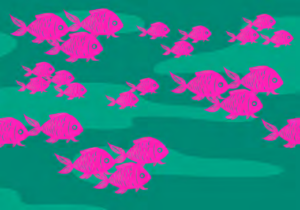

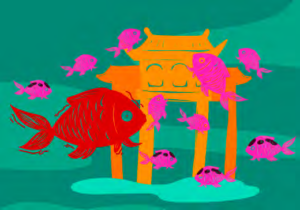
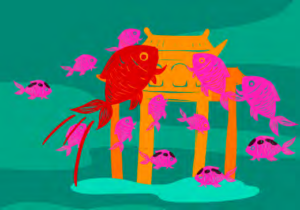
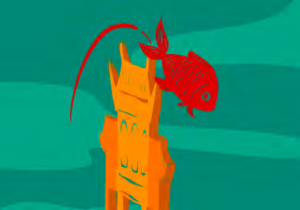

Set Dressing Mood References
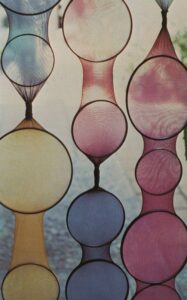
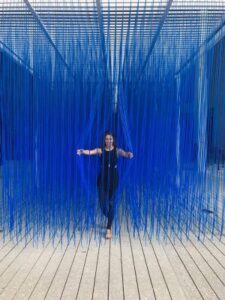
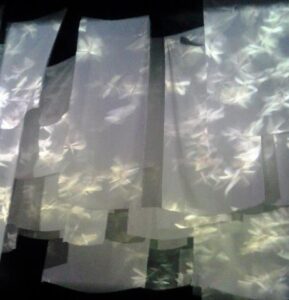
Making screens out of fabric
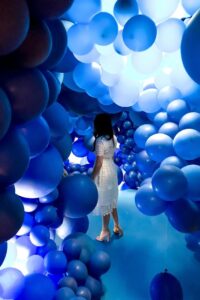
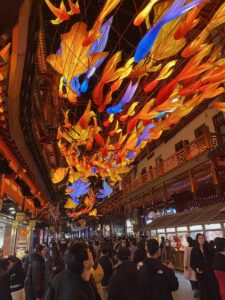
Ballons imitate crouding fish / Fish lantern exhibition at Shanghai
Theatre Study
It is a theatre with a screen made of transparent strip curtains, named Hamlet. Directed by Thomas Ostermeier.
We would like to apply this idea in our performance to introduce audiences to the more significant stage site behind, letting them find the joy of exploration in this.
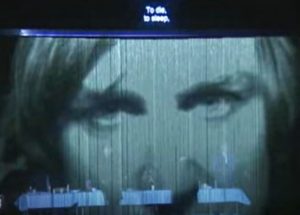
The installation Christian Boltanski by Marcos Rabello, shows the flickering light cast onto the wall and the shadows of little figures. We intend to cast audiences’ shadows in this way, transform them from spectatorship to being part of the performance and enhance participation. However, we need to address and experiment with the issue of audience members misunderstanding that they are blocking the projection and hiding from the lights. Our goal is to find effective ways to communicate to the audience that they are invited to participate.
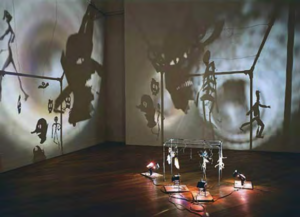
Experiment
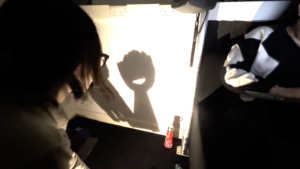
A test of the projector inspired by Christian’s work
Interactive Installation Research
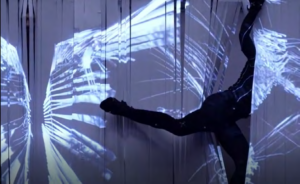
Explore the possibility of creating a soft screen by projector and curtain for audience members to walk through.

Use different coloured lights to highlight the main characters. Or consider, shadow show can also be a form.
Site Inspection
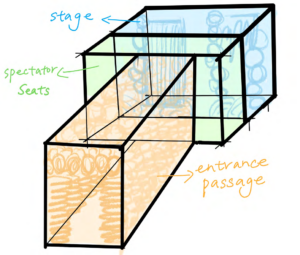


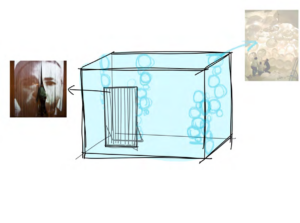
We aimed for an immersive stage experience, divided into three sections: the entry tunnel (orange), performance area (blue), and viewing area (green).
The entrance allows audiences to pass through a narrow, decorated passageway resembling the ocean environment of carp. The narrow space is decorated with balloons and coral to simulate the environment of carp in the ocean. We aim to let the audience understand the survival of the carp in the water through this crowded environment.
Upon entering the viewing area, projections in the performance area and on the sides will enhance immersion. Yet, details regarding projection equipment usage and room setup are still pending.
We propose to make an additional foreground curtain on the left side of the central performance area. This versatile curtain serves as both a projection surface and an entry/exit point for actors, enhancing stage hierarchy and facilitating actor movement.
Next, we will visit the designated rooms for field measurements to make necessary adjustments and refine the design for accuracy based on the room’s dimensions.
The Modified Design
We made modifications to the setup based on the data from the field measurements (right image).
As you can see, the room will be divided into a small square film theatre in the centre, with a ring of encircling passages around it. Red arrows show the viewing route, which will then be guided by props.
The image below is the previous set dressing idea, which references and illustrations are provided to illustrate the prototype.
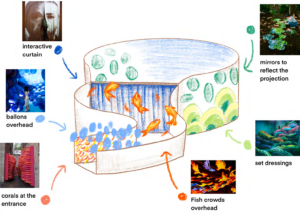
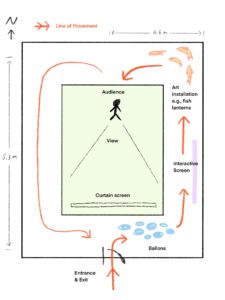
Concept Illustration
To illustrate the conceptual design of our set, I have drawn a schematic storyboard to follow an audience member through the experience of our performance from a third-person perspective.
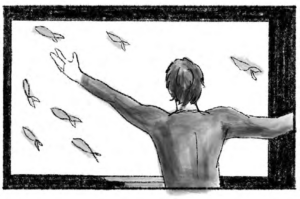
1.1) There will also be an interactive screen in the passway, adding engagement.

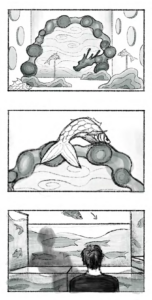
1) The entrance passway is decorated with balloons to simulate the fish crowding.
2) Fish lamps hanging overhead, introduce the context of their living conditions.
3) Follow the projection with crowding moving forward, walking through the curtain to see the next scene behind.
4) Follow the projection with crowding moving forward, walking through the curtain to see the next scene behind.
5) Follow the projection with crowding moving forward, walking through the curtain to see the next scene behind.
6) All lights go out, leaving only bottom lighting behind the audience. Their shadows merge with the projected aquarium.
Projected Video Demo
The projecton background mainly explains the environment in which the story develops. The projecton is mainly divided into three scenes: the river environment that creates the life of the carp, the rough river surface when the carp leaps the Dragon Gate, and the carp leaping through the empty door to enter the Heavenly Court.
As a traditonal Chinese story, the design of the background also incorporates Chinese style, hoping to reflect the cultural background of the story.
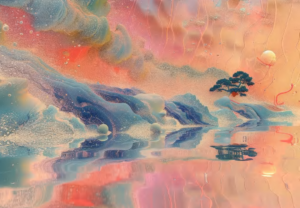
Projection Scene Demo 1, Rough river, painted with colour blocks, generated with AI
Projection Effect Test
-
- Chromatic Aberration Problem
During our testing of the place andprojector, we discovered that the colors did not match as anticipated, so that the mage did not appear as expected.
-
- Size adaptability between Projection andImage.
After many attempts, we found that the range and distance of projection equipment we currently use do not match the images in our works.
Response:
We would investigate the next steps, practice the application of the projector, adjust the scale of the image and be flexible in the choice of projection equipment according to practice.
Technical Details
Touch Designer for Interactve Dialogue and Background
Touch Designer Image Partcle
Scene One: crowding living conditions.
Particle effect: using particle technology to simulate the crowding in the river.
With Touch Designer, we could create streams of particles that look like fishes, which allows the audience to control the fish swimming directions by waving their arms.
Scene Three: toward the illusory dragon gate.
Particle effect: the particle gantry may change suddenly, releasing light particles that appear to attract but push the carp toward the trap.
Visual cue: as the carp get captured, the particles on stage shift from an orderly flow to an eruption of chaos, symbolising betrayal and pain.
Scene Five: fall into the aquarium
Particle effect: in the end, the particles in the scene can gradually disappear until the stage is completely darkened, leaving the audience to ponder.
Touch Designer Camera Hand Recogniton Partcle Interacton
Touch Designer Image Partcle
Technical implementaton
General Description
This approach carries the risk of audio-video desynchronization, so our priority is to use a single software for production
Interective Sound Installation
For this part , we’ve created a demo of interactive sound effects using ProTools’ 5.1 surround sound format. This demo ranges from normal whispers with a slight reverb to distorted, heavily reverberated sounds resembling a dragon’s rumble, with added surround sound effects.
Given the space constraints in the Scene 1 corridor where the actual setup will take place, it might not be feasible to use surround sound speakers. To address this, we can render the surround sound content in binaural format, which is then outputted to headphones.
This approach allows for an immersive audio experience using a headphone amplifier, supporting multiple audience members simultaneously. This method ensures that the spatial quality of the sound is maintained, providing a realistic and engaging auditory experience that complements the visual and interactive elements of the scene.
https://drive.google.com/file/d/1eaQXOGu59cZgbWMIUCUkM2u7VTatm0as/view?usp=share_link (5.1 dialogue sound design
Possible lines:
“Beyond the gate, freedom calls.”
“Leap into your destiny, find your strength.”
“Embrace the unknown, for it holds your liberation.”
“In the leap, lies the path to transformation.”
“Dare the impossible, become the unimaginable.”
“Seek the gate, embrace your true form.”
“The gate beckons, promising a new dawn.”
“Cross the threshold, claim your power.”
“In the leap, your chains break.”
“The gate is the key, unlock your potential.”
Particle Animation
ADJ MyDMX Controller for Lighting Control
Protools & Live for Immersive Sound Design
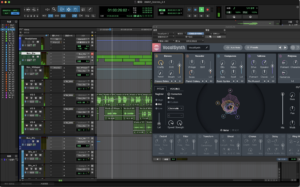
Protools Session Dialogue Design
Sound Environment Demo Audio Link: https://drive.google.com/file/d/1fp9mix5ti7y1oirtB_dtwCjSIWte-D0t/view?usp=share_link
Original music composition demo & Cultural Background
Link of demo:

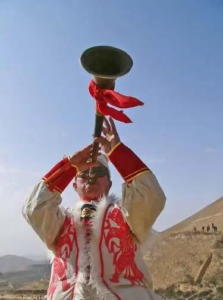
To furthermore, this original demo maintains plenty of Chinese traditional elements, for example Chinese pentatonic scales, as well as a part of Chinese traditional music instruments. The entire composition is structured into three distinct parts:
To begin with, the first section delineates the environment, spotlighting the protagonist (the carp) navigating its existence within the polluted waters, some Chinese traditional instruments like Instruments‘XUN’, evoked a somber and murky ambiance.
Additionally, the second segment delves into the character’s actions, emphasizing its leap over the dragon gate and the ensuing series of endeavors.
Next, the third part crescendos into the climax of the piece.Instruments such as the Suona, Pipa, and Bamboo Flute build upon the atmosphere layer by layer, culminating in a climactic finale. The unique technique of the Suona unveils the resolution of the story.
Risk Assessment
-
- Insufficient budget: materials for the set dressing, such as iron frame and curtain to be purchased, which leads to a high cost. The soluton is to adjust the scope of the project without compromising the core objectves of the project, and examine the project budget to evaluate the unnecessary expenses that can be cut or replaced with something else at a lower price. This may include reducing certain features, simplifying the design, or changing the way the project is delivered.
-
- Shortage of equipment: we have to book the required equipment two weeks in advance before our performance, (Bookit could be booked up to two weeks in advance). Moreover, we should consider some alternatve equipment as plan B.
-
- Technical challenges: seek advice and help from relevant professionals when computer system problems lead to program errors. the connecton between devices is a big difficulty because of the need to use sensors and touchable screens to interact. For wirelessly connected devices such as ZIG SIM and touch designer, check and test the network environment in advance. For wired devices such as lights and computers, prepare spare cables in advance to prevent problems with the wiring.
-
- Insufficient project human resources: due to the shortage of site resources, we have to arrange more devices, arriving at the site in advance is necessary. Prioritse tasks (ensure that the most important tasks are assigned to a single person to complete, and one person can take charge of two tasks for simple or minor tasks). Find friends who are willing to help and invite them to help set up the scene once the tme is not enough.
Further Expectaton
To begin with, try out and solve problems with the practcality of all technologies, then adjust and improve them, including equipment, sound effects, music, lightng control and image display.
Secondly,to enhance project completon, team members created props, sound effects, lightng, and music, all while staying in touch, sharing ideas, and coordinatng the tmelines to ensure each component is finished on schedule.
Finally,stay vigilant for any project issues as they arise, and address them promptly to enhance workflow efficiency.

